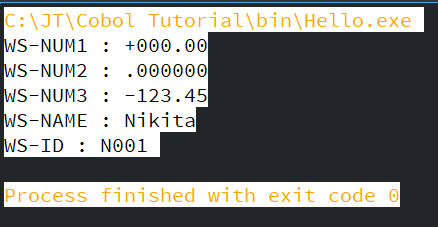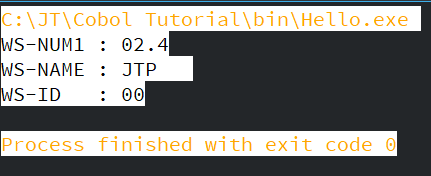COBOL - Data TypesIn programming languages, a data type or simply a type is an attribute of data which is used to explain the compiler or interpreter how the programmer intends to use the data. Every programming language must have data types. So, data types are used to define the type of variables used in a program. In COBOL program, data division defines the variables used in the program. You must understand the following terms to describe data in the COBOL. Let's see the following terms:

Level NumberA level number defines in which position or level, we can define a data in the record.
Elementary Items Elementary items are the indivisible items. An elementary item contains a level number, picture clause, data name, and value clause (optional). Group Items It is a set of one or more elementary items. A group item contains a level number, data name, and value clause (optional). The level number for group items is always 01. Example:Data NameIn the data division section, data names must be specified before they are used in the procedure division. Data names must have a name specified by the user; the reserved words cannot be used. Data names refer to the memory locations where the actual data is stored. There can be elementary items or group items. Example:Picture ClausePicture Clause defines the following items: Data Type: It may be of any type like numeric, alphanumeric, or alphabetic.
Sign: With numeric data, this can be used. It can either be - or +. Decimal Point Position: With numerical data, this can be used. The assumed decimal point enables the decimal values to store the period or dot (.). Length: Length is used to describe the amount of bytes that the data item will use.
Example:Let's see one example to show the PIC Clause: Output: 
Value ClauseThe value clause is an optional clause for initializing data objects. The values may be numeric literal, figurative constant, or alphanumeric literal. The value clause can be used with elementary items as well as group items. Example:Let's see the example for VALUE Clause: Output: 
Data type definitions for COBOLIn the following table, we are explaining the data type definitions and their descriptions for COBOL:
Next TopicCOBOL Verbs
|
 For Videos Join Our Youtube Channel: Join Now
For Videos Join Our Youtube Channel: Join Now
Feedback
- Send your Feedback to [email protected]
Help Others, Please Share










